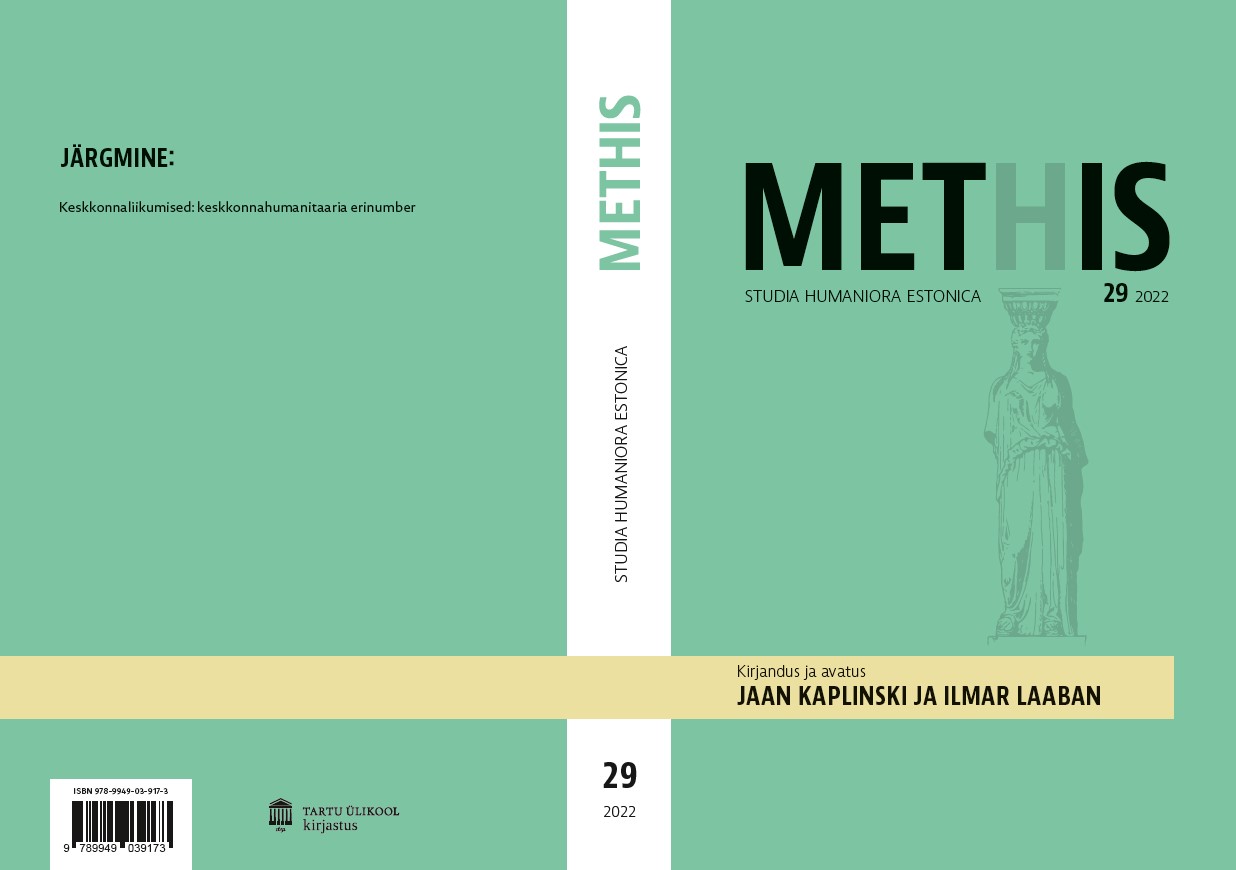Ilmar Laabani (luule)dialoog Paul Celani ja Nelly Sachsiga / Ilmar Laaban’s (poetic) dialogue with Paul Celan and Nelly Sachs
DOI:
https://doi.org/10.7592/methis.v23i29.19031Keywords:
kirjavahetused, eksiil, Ilmar Laaban, Paul Celan, Nelly Sachs, epistolaria, exileAbstract
Ilmar Laabani pärandi hulgas Eesti Kirjandusmuuseumi Eesti Kultuuriloolises Arhiivis on säilinud mõned näited tema saksakeelsest kirjavahetusest kahe saksa-juudi luuletajaga: kolm koopiat kirjadest tema eakaaslasele Paul Celanile (1920–1970) ja mõned kirjamustandid Nelly Sachsile (1891–1970), kes mõned aastad hiljem pälvis Nobeli kirjanduspreemia. Laaban rootsindas mõlema luuletaja tekste ning tõlkis valiku nende luuletustest ka eesti keelde. Artikkel käsitleb Laabani kirjanduslikku dialoogi Celani ja Sachsiga, mis kujunes kirjade, kohtumiste ning eeskätt luuletõlgete kaudu. Artikli teises pooles analüüsitakse Celani luule eestindusi, mille Laaban avadas Manas 1957–1958.
---
In the archive of the Estonian poet Ilmar Laaban, conserved at the Estonian Literary Museum in Tartu, we find three copies of his drafts of letters (in German) to his contemporary, the German Jewish poet Paul Celan (1920–1970) and four drafts (in German) of letters to the German Jewish poet and Nobel laureate Nelly Sachs (1901–1970). Laaban was personally acquainted with both Celan and Sachs, translated their poetry into Swedish, and published a small selection of each in Estonian translation. Celan’s first meeting with Laaban in Paris in 1951 is mentioned in Celan’s letter to Hannelore Scholz (Celan 2019, 94), and in one of Laaban’s letters (1952). Their correspondence began in 1954 and lasted until Celan’s death in 1970.
Though it might seem that such a spare, if not to say skeletal group of letters barely constitutes an analysable sample, this article responds with the claim that it offers significant traces of these poets’ “elective affinities”. Indeed, this portion of Laaban’s epistolarium stands as a synecdoche of much richer dialogues. “Dialogical moments” occur both in epistolary communication and in the translation process. Letters usually carry metacommunicative signals, references to other letters, or other texts, expanding the possibilities of interpretation and contextualisation.
When researching epistolaria it is not unusual to find only the letters of one party. Reasons are varied: general carelessness with one’s papers, improper sorting of a personal archive, an accident, or an intentional culling and erasure of epistolary texts. In Laaban’s case it is difficult to decide on the reason, as his correspondence (and the whole of his personal archive) only became better tended when he began living with Aino Tamjärv in 1981. There is a tone of warmth in Laaban’s drafts of letters to Sachs, and they both use the informal personal pronoun Du. The only surviving letter from Sachs to Laaban, a postcard for his birthday in 1955 points to a long-lasting friendship, including visits. Laaban’s letters to Celan are more distant, use the formal pronoun Sie and are primarily concerned with choices about translations into Swedish from Celan’s first published poetry collection, Mohn und Gedächtnis (The Poppy and Memory).
The first part of this article closely examines the archival evidence on the correspondences, using additional material from the clean copies of Laaban’s letters from the Celan archive in Marburg, mentions of Laaban in Celan’s Collected Letters, as well as Sachs and Celan’s correspondence with each other from 1954 until Celan’s death by suicide in 1970; Sachs died in Sweden the same year. Such analysis yields several textual rhizomes for future research and calls for a more determined search for Laaban’s published Swedish translations of Celan’s and Sachs’ poetry in literary periodicals in Sweden. Contextually, it must be mentioned that Laaban corresponded with literary scholars, visual artists, critics, and journalists who were proponents of surrealism as a generative mode of post-war culture. The focus of the letters Laaban received is narrower here: discussion is limited to the history of surrealism, criteria for a verbal or visual text to be deemed surrealist, and the extent of the network of artists and writers throughout post-war Europe that aspired to its ideals. Laaban reminds his correspondents that surrealism is alive and well in Europe’s peripheries, including the Scandinavian countries. Indeed, Laaban’s first encounter with Celan and his works was in the context of surrealism. According to Celan, Laaban wrote and spoke impeccable French and Estonian, and he regarded him as a Swede, or rather a highly educated Estonian living in Stockholm
In contrast to these academic-sounding debates, Laaban’s letters to Celan and Sachs address the question of the in-betweenness and intermittency of exile experience. In addition, there is the broader issue of human illness, suffering and destruction (Zerstörung) in a dark chapter of history that is barely past. Though the Holocaust (avant la lettre) and destruction of Europe’s Jews are not specifically broached, in the experience of one or multiple exiles, Laaban is a “fate-companion” of Celan and Sachs.
The second part of this article is an analysis of Laaban’s lengthy article on Celan in the first two issues of the Estonian-language cultural journal Mana (1957–1958), an exile publication with broad international aims that attempted to break away from a singular focus on exile writers and confining arguments about the validity of exile vs homeland. Accompanying the article, as a significant step toward the Estonian reception of key post-war European writers, is a small selection of Laaban’s Estonian translations of Celan’s poetry.


